Multilevel Analysis of International Scientific Collaboration Network in the Influenza Virus Vaccine Field: 2006–2013
Abstract
1. Introduction
2. Theoretical Framework and Research Questions
- Research question 1: What are the main characteristics of international scientific collaboration (at the country, city, and institution levels) in the IVV field? What do the levels have in common, what are their differences, and how could they be integrated? These questions will be covered and explored in this paper.
- Research question 2: The aforesaid analysis has mainly examined the respective characteristic of all three levels of collaboration, but are there are any differences or similarities of three kinds of network structures? We attempt to apply Zipf’s law of Scientometrics [29] to make a profound analysis and theoretical explanation.
3. Materials and Methods
3.1. Data Collection
3.2. Research Methods
4. Results
4.1. Country Level
- With the elapse of time, international scientific collaboration is increasingly becoming more in-depth in the IVV field, while different countries present different developmental levels.
- The United States has the most international buddies and is the largest collaboration partner of other countries because it has the most multinational paper counts. Undoubtedly, it is worthy of being called the core figure in the country-level collaboration network (see Figure 3).
- European countries such as the United Kingdom, Germany, France, Italy, Belgium and The Netherlands have always been in the HH quadrant. By contrast with these countries, Denmark has often been marginalized and located in the LH quadrant.
- Among the Asian countries, Japan and China also performed quite well. In particular, Thailand through efforts over several years, entered a new quadrant during 2012–2013.
- Likewise, Canada and Australia reach international advanced level in 2008–2009.
4.2. City Level
4.3. Institution Level
4.4. Comparison
5. Conclusions and Discussion
Acknowledgments
Author Contributions
Conflicts of Interest
References
- Liu, T.X.; Peng, Z.-C. Possible Impacts of Influenza Pandemic on China’s Economy. J. Tsinghua Univ. Philos. Soc. Sci. 2007, 4, 11. [Google Scholar]
- Keogh-Brown, M.R.; Wren-Lewis, S.; Edmunds, W.J.; Beutels, P.; Smith, R.D. The possible macroeconomic impact on the UK of an influenza pandemic. Health Econ. 2010, 19, 1345–1360. [Google Scholar] [CrossRef] [PubMed]
- WHO. Up to 650 000 People Die of Respiratory Diseases Linked to Seasonal Flu Each Year. Available online: http://www.who.int/mediacentre/news/releases/2017/seasonal-flu/en/ (accessed on 17 April 2018).
- WHO. 10 Menaces sur la Santé Mondiale en 2018. Available online: http://www.who.int/features/2018/10-threats-global-heath/fr/ (accessed on 17 April 2018). (In French).
- Paul-Pierre, P. Emerging diseases, zoonoses and vaccines to control them. Vaccine 2009, 276, 6435–6438. [Google Scholar] [CrossRef] [PubMed]
- Guzman, M.V.; Sanz, E.; Sotolongo, G. Bibliometric study on vaccines (1990–1995) part I: Scientific production in iberian-american countries. Scientometrics 1998, 43, 189–205. [Google Scholar] [CrossRef]
- Garg, K.C.; Kumar, S.; Madhavi, Y.; Bahl, M. Bibliometrics of global malaria vaccine research. Health Inf. Libr. J. 2009, 26, 22–31. [Google Scholar] [CrossRef] [PubMed]
- Wiysonge, C.S.; Uthman, O.A.; Ndumbe, P.M.; Hussey, G.D. A bibliometric analysis of childhood immunization research productivity in Africa since the onset of the Expanded Program on Immunization in 1974. BMC Med. 2013, 11, 66. [Google Scholar] [CrossRef] [PubMed]
- Zhao, X.Y.; Sheng, L.; Diao, T.X.; Zhang, Y.; Wang, L.; Yanjun, Z. Knowledge mapping analysis of Ebola research. Bratislavskelekarskelisty 2014, 116, 729–734. [Google Scholar] [CrossRef]
- Olijnyk, N.V. An algorithmic historiography of the ebola research specialty: Mapping the science behind ebola. Scientometrics 2015, 105, 623–643. [Google Scholar] [CrossRef]
- Head, M.G.; Fitchett, J.R.; Lichtman, A.B.; Soyode, D.T.; Harris, J.N.; Atun, R. Mapping investments and published outputs in norovirus research: A systematic analysis of research funded in the United States and United Kingdom during 1997–2013. J. Infect. Dis. 2016, 213 (Suppl. 1), S3–S7. [Google Scholar] [CrossRef] [PubMed]
- Wagner, C.S.; Leydesdorff, L. Network structure, self-organization, and the growth of international collaboration in science. Res. Policy 2005, 34, 1608–1618. [Google Scholar] [CrossRef]
- Ye, X.; Liu, Y.; Porter, A.L. International collaborative patterns in China’s nanotechnology publications. Int. J. Technol. Manag. 2012, 59, 255–272. [Google Scholar] [CrossRef]
- Cheng, Y.; Liu, Y.; Fan, W. Research on the evaluation of nation nanotechnology innovation international level based on patent analysis. In Proceedings of the 2014 Portland International Conference on Management of Engineering & Technology (PICMET), Kanazawa, Japan, 27–31 July 2014; pp. 1373–1382. [Google Scholar]
- Bai, X.; Liu, Y. Exploring the Asian innovation networks (AINS) characteristics. Inf. Dev. 2017. [Google Scholar] [CrossRef]
- Zheng, J.; Zhao, Z.Y.; Zhang, X.; Chen, D.Z.; Huang, M.H. International collaboration development in nanotechnology: A perspective of patent network analysis. Scientometrics 2014, 98, 683–702. [Google Scholar] [CrossRef]
- Huang, Y.; Ma, J.; Porter, A.L.; Kwon, S.; Zhu, D. Analyzing collaboration networks and developmental patterns of nano-enabled drug delivery (NEDD) for brain cancer. Beilstein J. Nanotechnol. 2015, 6, 1666–1676. [Google Scholar] [CrossRef] [PubMed]
- Neal, Z. Differentiating centrality and power in the world city network. Urban Stud. 2011, 48, 2733–2748. [Google Scholar] [CrossRef]
- Guan, J.; Zhang, J.; Yan, Y. The impact of multilevel networks on innovation. Res. Policy 2015, 44, 545–559. [Google Scholar] [CrossRef]
- Chen, N.; Liu, Y.; Cheng, Y.; Liu, L.; Yan, Z.; Tao, L.; Guo, X.; Luo, Y.; Yan, A. Technology resource, distribution, and development characteristics of global influenza virus vaccine: A patent bibliometric analysis. PLoS ONE 2015, 10. [Google Scholar] [CrossRef] [PubMed]
- WHO. Global Action Plan for Influenza Vaccines. Available online: http://www.who.int/influenza_vaccines_plan/objectives/en/ (accessed on 17 April 2018).
- Yan, E.; Guns, R. Predicting and recommending collaborations: An author-, institution-, and country-level analysis. J. Informetr. 2014, 8, 295–309. [Google Scholar] [CrossRef]
- Ortega, J.L.; Aguillo, I.F. Institutional and country collaboration in an online service of scientific profiles: Google Scholar Citations. J. Informetr. 2013, 7, 394–403. [Google Scholar] [CrossRef]
- Bordons, M.; Aparicio, J.; Costas, R. Heterogeneity of collaboration and its relationship with research impact in a biomedical field. Scientometrics 2013, 96, 443–466. [Google Scholar] [CrossRef]
- Han, P.; Shi, J.; Li, X.; Wang, D.; Shen, S.; Su, X. International collaboration in LIS: Global trends and networks at the country and institution level. Scientometrics 2014, 98, 53–72. [Google Scholar] [CrossRef]
- Barnett, G.A.; Han, W.P.; Jiang, K.; Tang, C.; Aguillo, I.F. A multi-level network analysis of web-citations among the world’s universities. Scientometrics 2014, 99, 5–26. [Google Scholar] [CrossRef]
- Chen, K.; Yao, Q.; Sun, J.; He, Z.; Yao, L.; Liu, Z. International publication trends and collaboration performance of china in healthcare science and services research. Isr. J. Health Policy Res. 2015, 5, 75–79. [Google Scholar] [CrossRef] [PubMed]
- Lei, X.P.; Zhao, Z.Y.; Zhang, X.; Chen, D.Z.; Huang, M.H.; Zheng, J.; Liu, R.-S.; Zhang, J.; Zhao, Y. Technological collaboration patterns in solar cell industry based on patent inventors and assignees analysis. Scientometrics 2013, 96, 427–441. [Google Scholar] [CrossRef]
- Günther, R.; Levitin, L.; Schapiro, B.; Wagner, P. Zipf´s law and the effect of ranking on probability distributions. Int. J. Theor. Phys. 1996, 35, 395–417. [Google Scholar] [CrossRef]
- Gambaryan, A.S.; Robertson, J.S.; Matrosovich, M.N. Effects of egg-adaptation on the receptor-binding properties of human influenza A and B viruses. Virology 1999, 258, 232–239. [Google Scholar] [CrossRef] [PubMed]
- Wareing, M.D.; Tannock, G.A. Live attenuated vaccines against influenza; an historical review. Vaccine 2001, 19, 3320–3330. [Google Scholar] [CrossRef]
- Albert, N.; Miguel, M. Scientific production and international collaboration in occupational health, 1992–2001. Scand. J. Work Environ. Health 2004, 30, 223–233. [Google Scholar]
- Zheng, J.; Zhao, Z.Y.; Zhang, X.; Chen, D.Z.; Huang, M.H.; Lei, X.P.; Zhang, Z.; Zhao, Y. International scientific and technological collaboration of china from 2004 to 2008: A perspective from paper and patent analysis. Scientometrics 2012, 91, 65–80. [Google Scholar] [CrossRef]
- Annabeth, L. Propst. Think and explain with statistics. Technometrics 1988, 30, 233. [Google Scholar]
- Dodge, Y. The Oxford Dictionary of Statistical Terms; Oxford University Press: Oxford, UK, 2006. [Google Scholar]
- Freeman, L.C. Centrality in social networks conceptual clarification. Soc. Netw. 1978, 1, 215–239. [Google Scholar] [CrossRef]
- Freeman, L.C.; Roeder, D.; Mulholland, R.R. Centrality in social networks: II. Experimental results. Soc. Netw. 1979, 2, 119–141. [Google Scholar] [CrossRef]
- Prato, G.D.; Nepelski, D. Global technological collaboration network: Network analysis of international co-inventions. J. Technol. Transf. 2012, 39, 358–375. [Google Scholar] [CrossRef]
- Florida, R. Cities and the Creative Class; Routledge: Abingdon, UK, 2005. [Google Scholar]
- Wang, X.; Li, R.; Ren, S.; Zhu, D.; Huang, M.; Qiu, P. Collaboration network and pattern analysis: Case study of dye-sensitized solar cells. Scientometrics 2014, 98, 1745–1762. [Google Scholar] [CrossRef]
- Hou, Y.; Xia, Y.; Liu, T.; Lv, H. Research on Multi layered Scholarly Cooperation Network Based on Journal Articles and Patent. J. China Soc. Sci. Tech. Inf. 2014, 33, 1057–1066. [Google Scholar]
- Liming, L.; Lihua, L. Scientific publication activities of 32 countries.—Zipf-pareto distribution. Scientometrics 1993, 26, 263–273. [Google Scholar] [CrossRef]
- Wang, X.; Wang, W. Zipf-pareto distribution of medical papers from NSFC. Stud. Sci. Sci. 2006, 24, 47–49. [Google Scholar]
- Lin, D.; Chen, C.; Liu, Z. Statistical Characteristics of an Evolving Co-citation Network: The Distribution of Betweenness Centrality. In Proceedings of the International Conference on Scientometrics and Informetrics, Rio de Janeiro, Brazil, 28–31 July 2009; pp. 522–560. [Google Scholar]
- Lin, D.; Chen, C.; Zeyuan, A.L. Study on zipf-pareto distribution of the betweenness centrality of a co-citation network. J. China Soc. Sci. Tech. Inf. 2011, 30, 76–82. [Google Scholar]
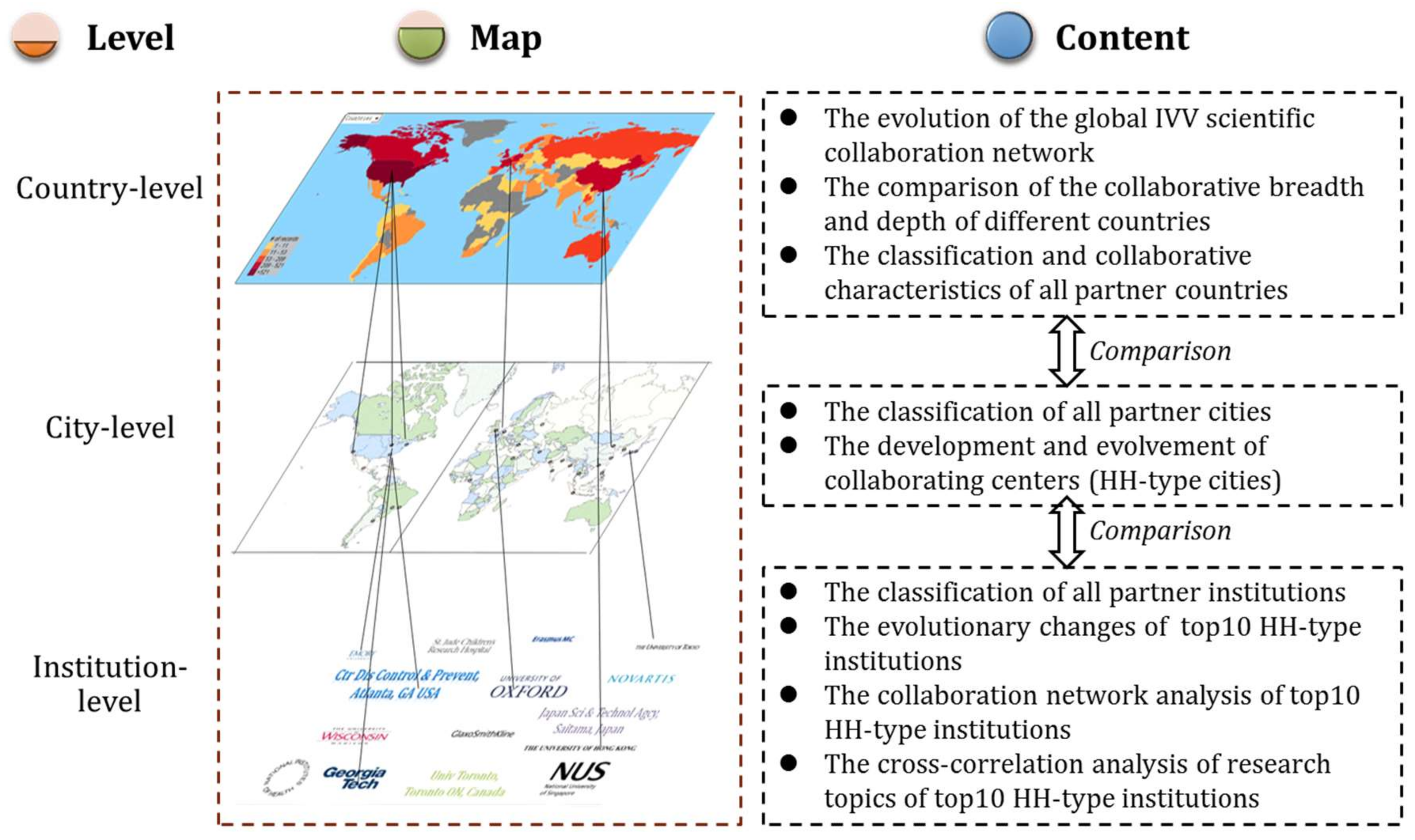
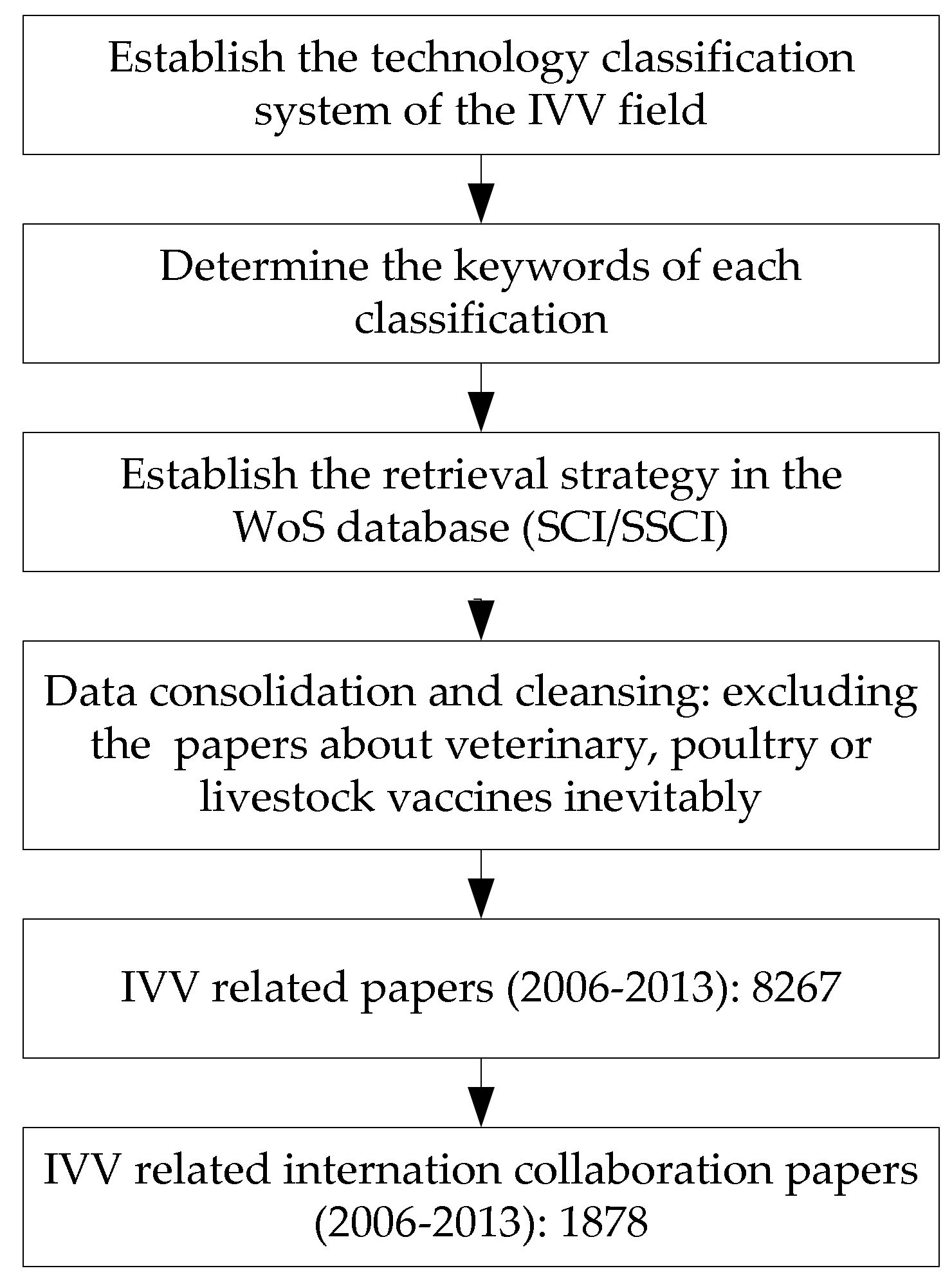
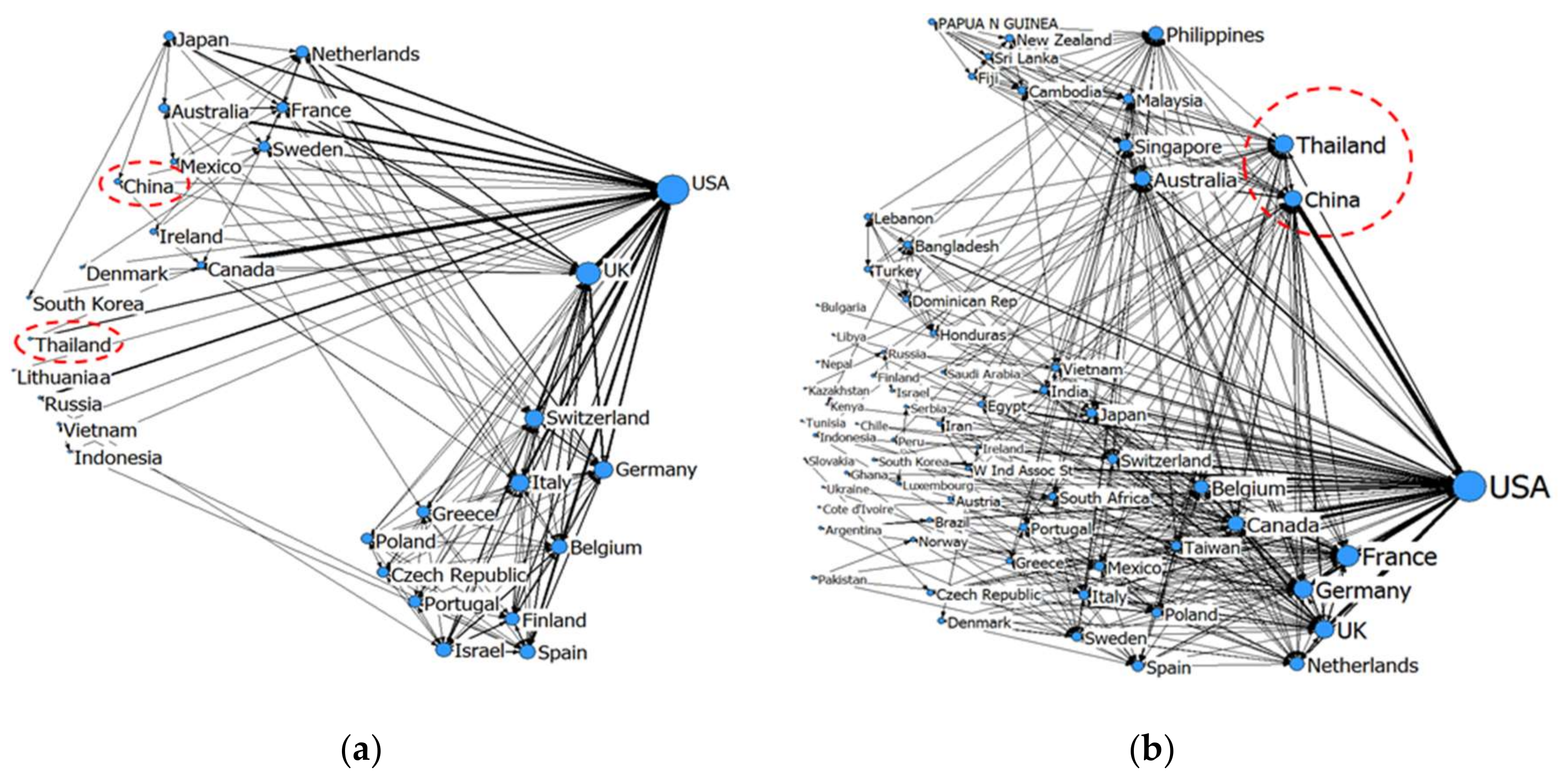
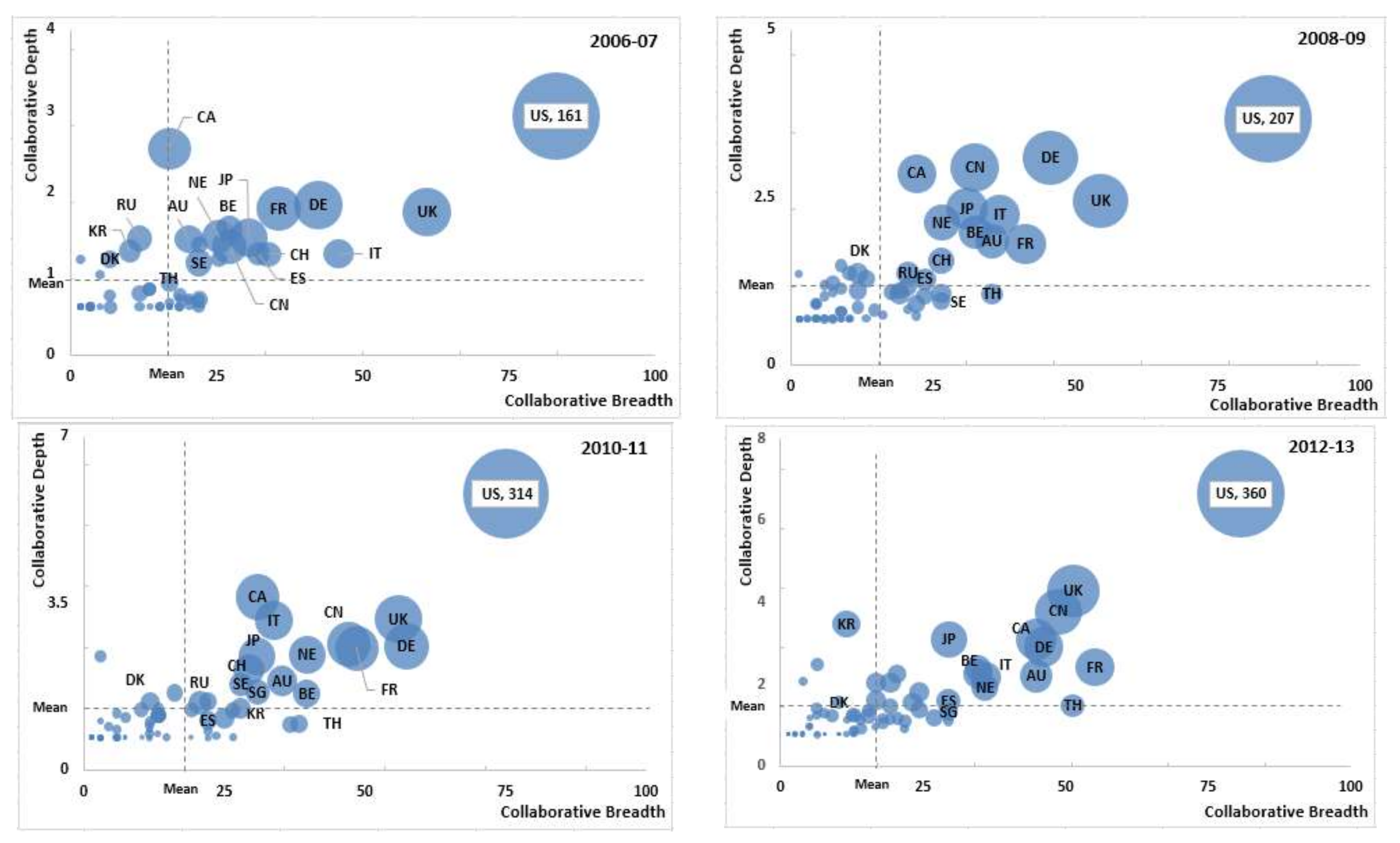
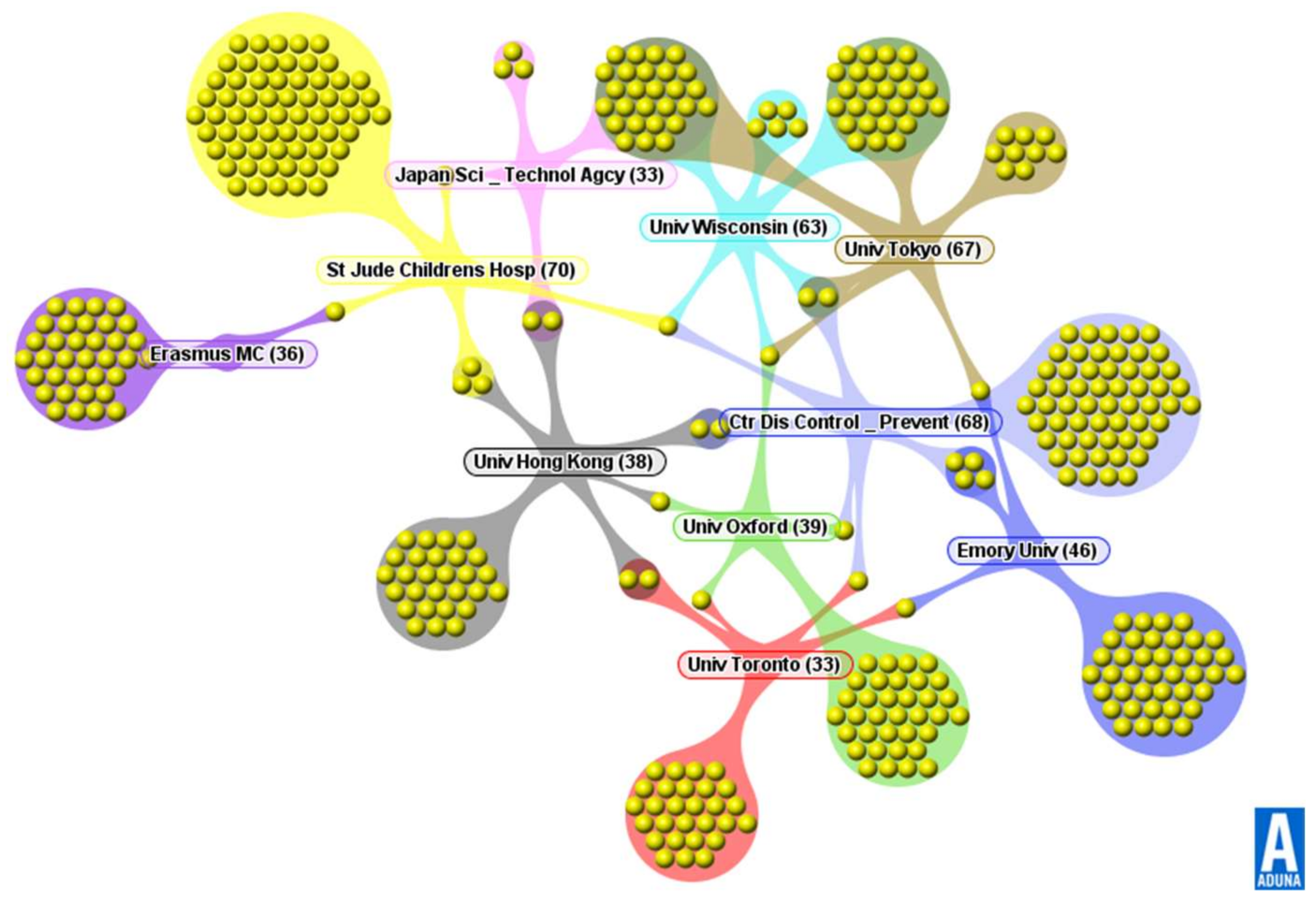
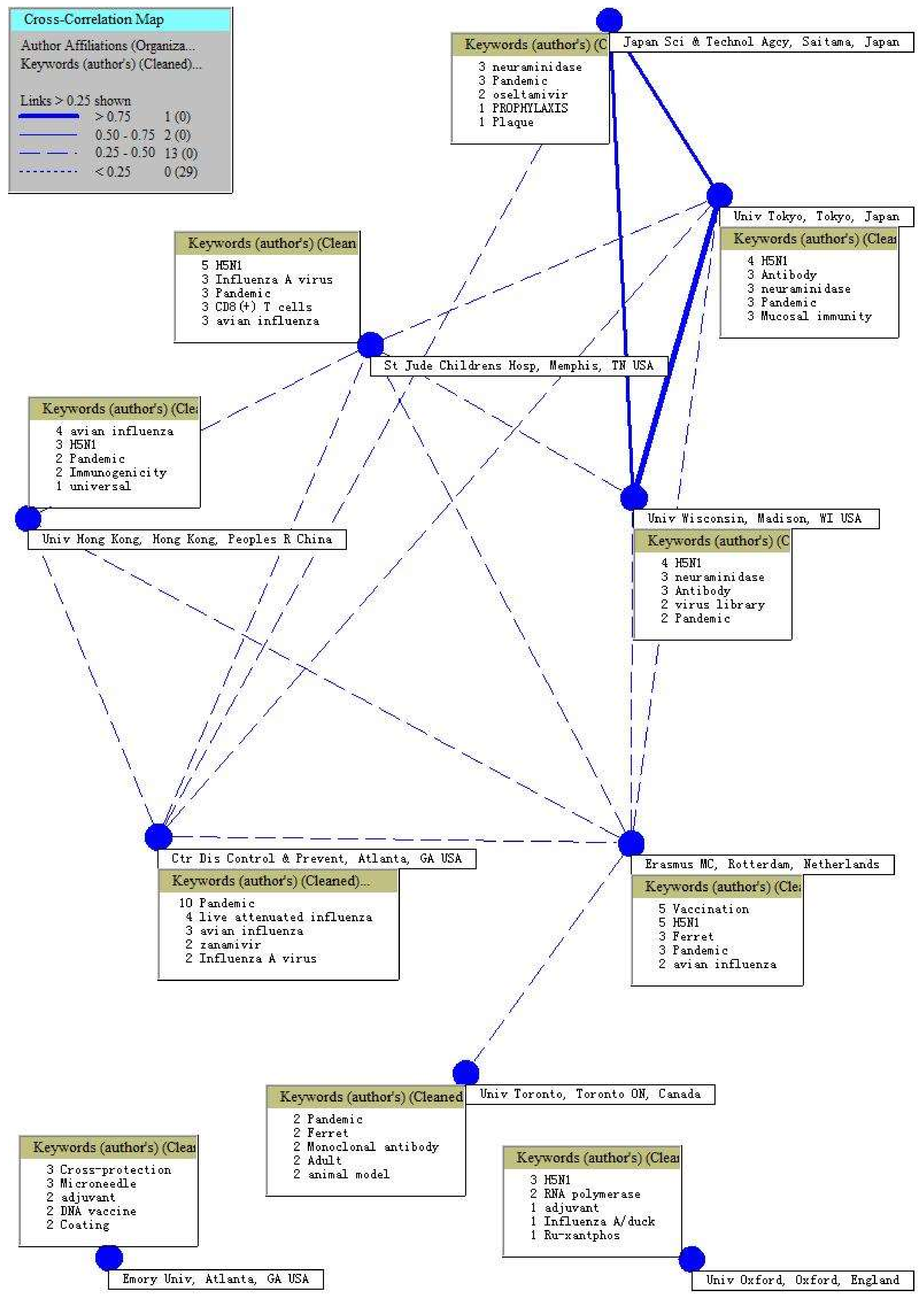
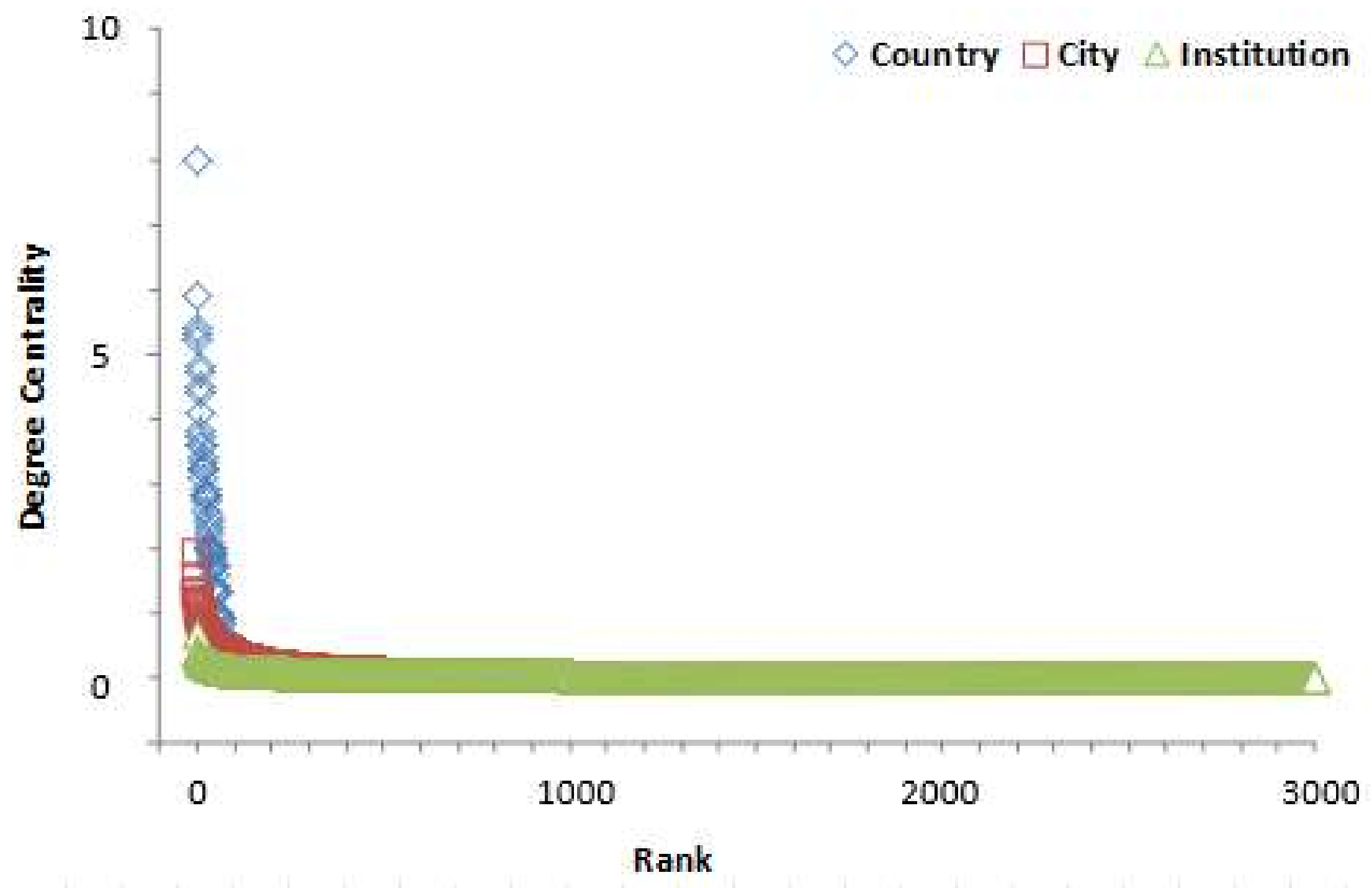
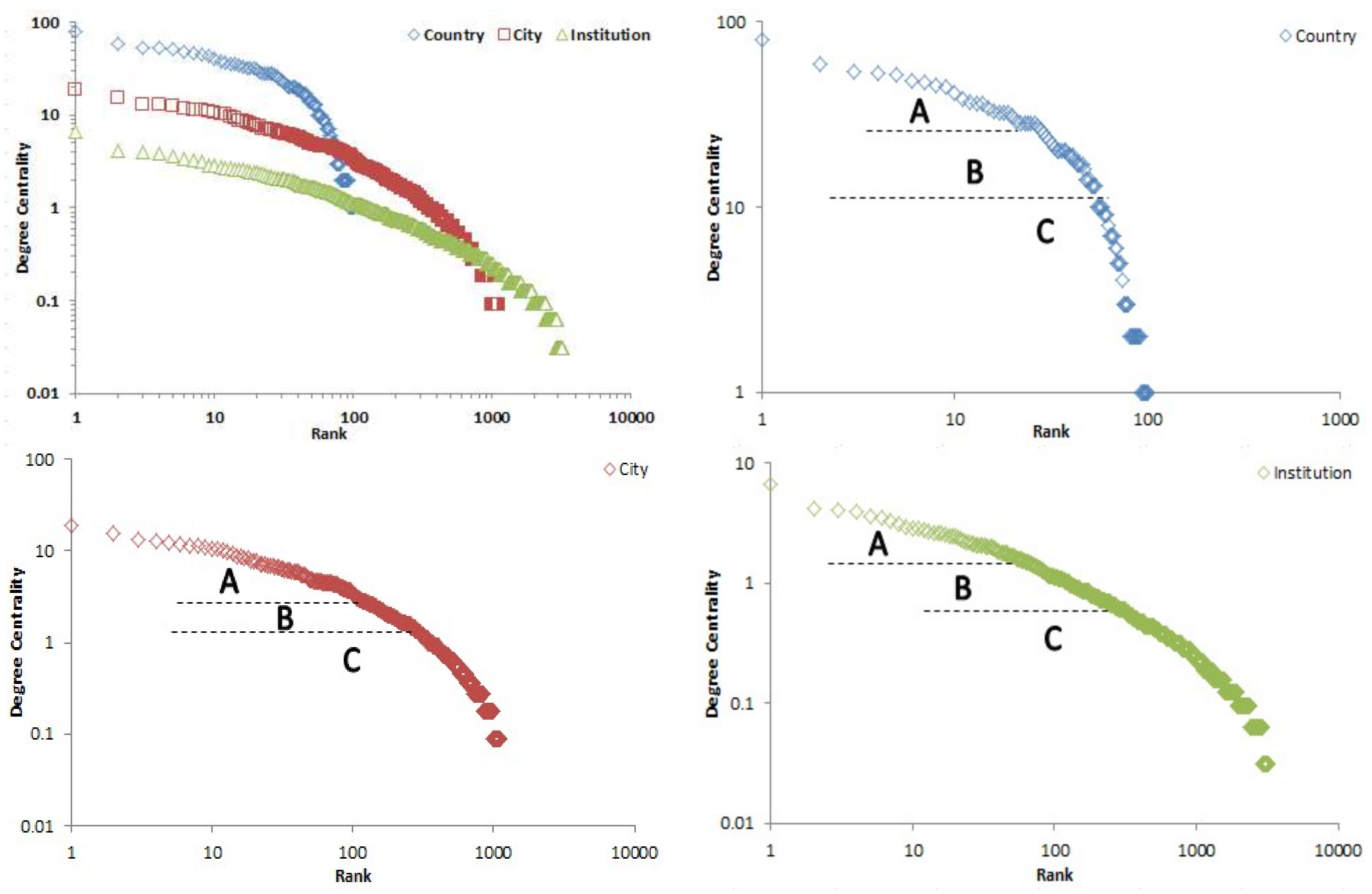
| Categories | Subcategories |
|---|---|
| inactivated vaccine | inactivated virus vaccine |
| split vaccine | |
| sub-unit vaccine | |
| live attenuated vaccine | live attenuated vaccine |
| recombinant vaccine | recombinant protein vaccine |
| recombinant vector vaccine | |
| recombinant DNA vaccine | |
| synthetic peptide vaccine | synthetic peptide vaccine |
| Year | 2006 | 2007 | 2008 | 2009 | 2010 | 2011 | 2012 | 2013 |
|---|---|---|---|---|---|---|---|---|
| Number of papers | 589 | 674 | 815 | 967 | 1188 | 1370 | 1305 | 1359 |
| Number of international collaboration papers | 119 | 154 | 179 | 220 | 275 | 303 | 305 | 323 |
| Percentage (%) | 20.20 | 22.85 | 21.96 | 22.75 | 23.15 | 22.12 | 23.37 | 23.77 |
| Type | CBI | CDI | Importance of Nodes | Characteristics |
|---|---|---|---|---|
| HH | High | High | Central | Extensive knowledge communication |
| HL | High | Low | Significant | A wide group of partners with lesser concentration and depth |
| LH | Low | High | General | In-depth knowledge communication with certain partners |
| LL | Low | Low | Fringe | Play a relatively minor role in knowledge exchange activities |
| Rank | 2006–2007 | 2008–2009 | 2010–2011 | 2012–2013 |
|---|---|---|---|---|
| Collaborating Centers | Collaborating Centers | Collaborating Centers | Collaborating Centers | |
| 1 | Tokyo, Japan | London, UK ↑ | Atlanta, GA, USA ↑ | Atlanta, GA USA |
| 2 | London, UK | Tokyo, Japan ↓ | London, UK ↓ | London, UK |
| 3 | Memphis, TN, USA | Atlanta, GA, USA ↑ | Tokyo, Japan ↓ | Tokyo, Japan |
| 4 | Lyon, France | Vic, Australia ↑ | New York, NY, USA ↑ | Beijing, China ↑ |
| 5 | Vic, Australia | Siena, Italy ↑ | Beijing, China ↑ | Boston, MA, USA ↑ |
| 6 | Paris, France | Berlin, Germany ★ | Singapore, Singapore ↑ | Bethesda, MD, USA ↑ |
| 7 | Atlanta, GA, USA | Rotterdam, The Netherlands ★ | Bethesda, MD, USA ↑ | Hong Kong, China ↑ |
| 8 | Bethesda, MD, USA | Marburg, Germany ↑ | Lyon, France ↑ | Madison, WI, USA ↑ |
| 9 | Athens, GA, USA | Memphis, TN, USA ↓ | Memphis, TN, USA | Seoul, Korea ↑ |
| 10 | Moscow, Russia | Beijing, China ★ | Berlin, Germany ↓ | Paris, France ↑ |
| 11 | Seoul, Korea | New York, NY, USA ↑ | Toronto, ON, Canada ↑ | Vic, Australia ↑ |
| 12 | Birmingham, AL, USA | Madison, WI, USA ↑ | Madison, WI, USA | New York, NY, USA ↓ |
| 13 | Madison, WI, USA | Boston, MA, USA ↑ | Saitama, Japan ↑ | Saitama, Japan |
| 14 | Hokkaido, Japan | NSW, Australia ★ | Paris, France ↑ | Bangkok, Thailand ↑ |
| 15 | Boston, MA, USA | Moscow, Russia ↓ | Siena, Italy ↓ | Hanoi, Vietnam ↑ |
| 16 | St Louis, MO, USA | Lyon, France ↓ | Boston, MA, USA ↓ | Cambridge, MA, USA ↑ |
| 17 | Siena, Italy | St Louis, MO, USA ↓ | Marburg, Germany ↓ | Memphis, TN, USA ↓ |
| 18 | Marburg, Germany | Hong Kong, China ★ | Oxford, UK ↑ | Siena, Italy ↓ |
| 19 | Stockholm, Sweden | Winnipeg, MB, Canada ↑ | Hong Kong, China ↓ | Singapore, Singapore ↓ |
| 20 | New York, NY, USA | Toronto, ON, Canada ★ | Vic, Australia ↓ | NSW, Australia ↑ |
| 21 | Freiburg, Germany | Oxford, UK ★ | Rotterdam, The Netherlands ↓ | Lyon, France ↓ |
| 22 | Herts, UK | Saitama, Japan ↑ | Athens, GA, USA ↑ | Oxford, UK ↑ |
| 23 | Utrecht, The Netherlands | Singapore, Singapore ↑ | Cambridge, MA, USA ★ | Mexico City DF, Mexico ↑ |
| 24 | Gaithersburg, MD, USA | Louvain, Belgium ★ | Shanghai, China ↑ | Cambridge, UK ↑ |
| 25 | Bangkok, Thailand | Fife, UK ★ | Winnipeg, MB, Canada ↓ | Ottawa, ON, Canada ↑ |
| 26 | Saitama, Japan | Marcy Letoile, France ★ | Hanoi, Vietnam ↑ | Shanghai, China ↓ |
| 27 | Emeryville, CA, USA | Rome, Italy ★ | NSW, Australia ↓ | Winnipeg, MB, Canada ↓ |
| 28 | Gothenburg, Sweden | Qld, Australia ★ | Geneva, Switzerland ↑ | Toronto, ON, Canada ↓ |
| 29 | Pearl River, NY, USA | Shanghai, China ★ | Utrecht, The Netherlands ↑ | Birmingham, AL, USA ↑ |
| 30 | Edmonton, AB, Canada | Baltimore, MD, USA ★ | Rome, Italy ↓ | Vienna, Austria ★ |
| 31 | Basel, Switzerland | Aarhus, Denmark ★ | Amsterdam, The Netherlands ★ | Los Angeles, CA, USA ↑ |
| 32 | Winnipeg, MB, Canada | Pearl River, NY, USA ↓ | Baltimore, MD, USA ↓ | Seattle, WA, USA ↑ |
| 33 | Geneva, Switzerland | Ghent, Belgium ★ | Hamilton, ON, Canada ★ | Baltimore, MD, USA ↓ |
| 34 | Zurich, Switzerland | Auckland, New Zealand ★ | Cambridge, UK ★ | Zurich, Switzerland ↑ |
| 35 | Antwerp, Belgium | Rixensart, Belgium ★ | Philadelphia, PA, USA ★ | Geneva, Switzerland ↓ |
| 36 | Bilbao, Spain | San Diego, CA, USA ★ | Freiburg, Germany ↑ | Wavre, Belgium ↑ |
| 37 | Petah Tiqwa, Israel | Hokkaido, Japan ↓ | Seattle, WA, USA ★ | Madrid, Spain ★ |
| 38 | Marseille, France | Haerbin, China ★ | Haerbin, China | La Jolla, CA, USA ↑ |
| 39 | FIN-Tampere, Finland | Herts, UK ↓ | Stockholm, Sweden ↑ | Philadelphia, PA, USA ↓ |
| 40 | Ann Arbor, MI, USA | Hanoi, Vietnam ★ | Vancouver, BC, Canada ↑ | Rotterdam, The Netherlands ↓ |
| 41 | Farmington, CT, USA | Birmingham, AL, USA ↓ | Montreal, PQ, Canada ★ | Ann Arbor, MI, USA ↑ |
| 42 | Surrey, UK | Cincinnati, OH, USA ★ | Pittsburgh, PA, USA ★ | Stockholm, Sweden ↓ |
| 43 | Singapore, Singapore | Shiga, Japan ★ | ACT, Australia ★ | Cincinnati, OH, USA ↑ |
| 44 | Milan, Italy | Munster, Germany ★ | St Petersburg, Russia ★ | Osaka, Japan ★ |
| 45 | W Midlands, UK | Wurzburg, Germany ★ | Ames, IA, USA ★ | Moscow, Russia ↑ |
| Top10 Institutions | Total # | All Years | 2006–2007 | 2008–2009 | 2010–2011 | 2012–2013 |
|---|---|---|---|---|---|---|
| St Jude Childrens Hosp, Memphis, TN, USA | 70 | 1 | 1 | 2 | 1 | 7 |
| Ctr Dis Control & Prevent, Atlanta, GA, USA | 68 | 2 | 2 | 4 | 4 | 1 |
| Univ Tokyo, Tokyo, Japan | 67 | 3 | 5 | 1 | 2 | 2 |
| Univ Wisconsin, Madison, WI, USA | 63 | 4 | 4 | 3 | 3 | 3 |
| Emory Univ, Atlanta, GA, USA | 46 | 5 | LL | 7 | 6 | 4 |
| Univ Oxford, Oxford, UK | 39 | 6 | HL | 11 | 11 | 10 |
| Univ Hong Kong, Hong Kong, China | 38 | 7 | HL | HL | 14 | 6 |
| Erasmus MC, Rotterdam, The Netherlands | 36 | 8 | HL | 6 | 5 | 5 |
| Japan Sci&Technol Agcy, Saitama, Japan | 33 | 9 | 19 | 12 | 10 | 8 |
| Univ Toronto, Toronto, ON, Canada | 33 | 10 | LL | 10 | 7 | 9 |
| Interval | Rank | A | B | Adjusted R Square | Degree | Number of Nodes | Share (%) | |
|---|---|---|---|---|---|---|---|---|
| Country level | A | 1~21 | −0.3070 | 1.9036 | 0.9663 | 29~80 | 21 | 20.79 |
| B | 22~50 | −0.8800 | 2.6707 | 0.9532 | 14~28 | 29 | 28.71 | |
| C | 51~101 | −0.8800 | 8.2892 | 0.9622 | 1~13 | 51 | 50.50 | |
| City level | A | 1~97 | −0.4038 | 1.3898 | 0.9747 | 3.62~18.914 | 97 | 8.77 |
| B | 98~258 | −0.8573 | 2.2386 | 0.9920 | 1.538~3.529 | 161 | 14.56 | |
| C | 259~1106 | −1.9549 | 5.0284 | 0.9393 | 0.09~1.448 | 848 | 76.67 | |
| Institution level | A | 1~53 | −0.3211 | 0.7825 | 0.9854 | 1.63~6.583 | 53 | 1.66 |
| B | 54~228 | −0.5823 | 1.2182 | 0.9957 | 0.721~1.599 | 175 | 5.48 | |
| C | 229~3191 | −1.1734 | 2.8304 | 0.9117 | 0.031~0.69 | 2963 | 92.85 | |
© 2018 by the authors. Licensee MDPI, Basel, Switzerland. This article is an open access article distributed under the terms and conditions of the Creative Commons Attribution (CC BY) license (http://creativecommons.org/licenses/by/4.0/).
Share and Cite
Liu, Y.; Cheng, Y.; Yan, Z.; Ye, X. Multilevel Analysis of International Scientific Collaboration Network in the Influenza Virus Vaccine Field: 2006–2013. Sustainability 2018, 10, 1232. https://doi.org/10.3390/su10041232
Liu Y, Cheng Y, Yan Z, Ye X. Multilevel Analysis of International Scientific Collaboration Network in the Influenza Virus Vaccine Field: 2006–2013. Sustainability. 2018; 10(4):1232. https://doi.org/10.3390/su10041232
Chicago/Turabian StyleLiu, Yun, Yijie Cheng, Zhe Yan, and Xuanting Ye. 2018. "Multilevel Analysis of International Scientific Collaboration Network in the Influenza Virus Vaccine Field: 2006–2013" Sustainability 10, no. 4: 1232. https://doi.org/10.3390/su10041232
APA StyleLiu, Y., Cheng, Y., Yan, Z., & Ye, X. (2018). Multilevel Analysis of International Scientific Collaboration Network in the Influenza Virus Vaccine Field: 2006–2013. Sustainability, 10(4), 1232. https://doi.org/10.3390/su10041232




